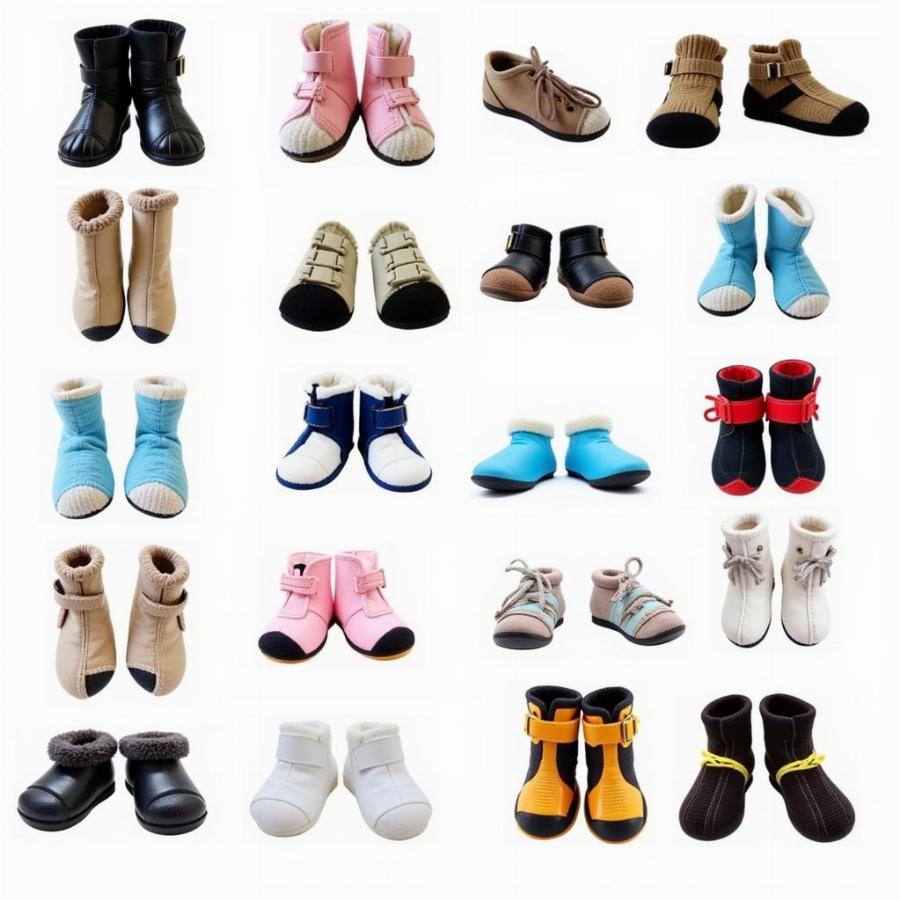Dog paw coverings are becoming increasingly popular, and for good reason! These handy accessories can protect your furry friend’s paws from a variety of hazards, both inside and outside the home. Whether you’re braving hot pavement, snowy sidewalks, or simply want to keep those paw pads pristine, dog paw coverings offer a practical and stylish solution. This comprehensive guide will delve into everything you need to know about dog paw coverings, from understanding their benefits and types to choosing the right fit and ensuring your dog’s comfort.
Why Consider Dog Paw Coverings?
Our canine companions’ paws are surprisingly sensitive, despite their tough exterior. Just like our bare feet, their paws are vulnerable to extreme temperatures, rough terrain, and harsh chemicals.
Here are some compelling reasons why dog paw coverings are a worthwhile investment:
- Protection from extreme weather: Dog paw coverings shield delicate paw pads from scorching hot pavement in the summer and icy sidewalks in the winter.
- Shielding from sharp objects: Whether it’s broken glass, thorns, or debris on hiking trails, paw coverings act as a barrier against potential injuries.
- Traction on slippery surfaces: Some dog paw coverings are designed with anti-slip soles, providing extra grip on slick floors or icy patches.
- Keeping paws clean: For dogs who love to explore, paw coverings can help minimize dirt, mud, and allergens from entering your home.
- Medical reasons: Dogs recovering from paw injuries or dealing with skin conditions may benefit from the protection and support offered by paw coverings.
Types of Dog Paw Coverings: Finding the Perfect Fit for Your Pup
 Different types of dog paw coverings
Different types of dog paw coverings
Just like shoes for humans, dog paw coverings come in various styles, each suited for different purposes and preferences.
Here’s a closer look at the most common types:
1. Dog Boots:
Dog boots offer the most comprehensive protection for your pup’s paws. They typically feature a durable outer sole, a breathable upper material, and secure fastening systems like buckles or Velcro straps. Dog boots are ideal for:
- Hiking and outdoor adventures: Providing superior protection against rough terrain, sharp rocks, and thorny bushes.
- Winter conditions: Keeping paws warm and dry in snow, ice, and slush. Look for boots with waterproof and insulated features.
- Hot pavement: Preventing burns and blisters from hot asphalt and concrete during summer walks.
2. Dog Socks:
Dog socks are a lightweight and flexible option for indoor and light outdoor use. They are usually made from breathable fabrics like cotton or mesh, often with anti-slip grips on the bottom. Dog socks are suitable for:
- Indoor traction: Providing extra grip for senior dogs or those prone to slipping on slick floors.
- Protecting furniture: Preventing scratches on hardwood floors and furniture.
- Keeping paws clean: Minimizing dirt and debris from being tracked into the house.
3. Disposable Dog Paw Coverings:
As the name suggests, these are single-use paw coverings, typically made from waterproof materials like rubber or plastic. They are convenient for:
- Quick trips outside: Ideal for potty breaks in wet weather or for dogs who don’t tolerate wearing boots or socks.
- Protecting paws from chemicals: Shielding paws from potentially harmful substances like lawn chemicals or road salt.
Choosing the Right Dog Paw Coverings: Size, Fit, and Comfort are Key
Finding the perfect fit for your dog’s paw coverings is crucial for their comfort and effectiveness.
Here are some essential tips to keep in mind:
- Measure your dog’s paws accurately: Use a flexible measuring tape and follow the manufacturer’s guidelines for measuring length and width.
- Consider your dog’s activity level: For active dogs, choose durable boots with secure fastenings. For indoor use or light walks, socks might be a more comfortable option.
- Prioritize breathability: Look for paw coverings made from breathable materials to prevent moisture buildup and discomfort.
- Introduce paw coverings gradually: Allow your dog to get accustomed to wearing paw coverings slowly, starting with short periods and gradually increasing the duration.
- Monitor for signs of discomfort: Check your dog’s paws regularly for any redness, irritation, or swelling.
Dog Paw Covering FAQs
Q: My dog hates having their paws touched. How can I get them used to paw coverings?
A: Patience and positive reinforcement are key. Start by handling your dog’s paws gently and rewarding them with treats. Gradually introduce the paw coverings, associating them with positive experiences.
Q: How often should I clean my dog’s paw coverings?
A: It’s best to clean them after each use, especially if they are visibly dirty or wet. Follow the manufacturer’s cleaning instructions to ensure longevity.
Q: Can dog paw coverings be used for dogs with arthritis?
A: Yes, some paw coverings can provide support and stability for dogs with arthritis, helping to reduce pain and improve mobility. Consult with your veterinarian for recommendations.
Beaut Dogs: Your Trusted Source for All Things Canine
For more insightful articles and expert advice on dog care, visit Beaut Dogs at https://beautdogs.com. At Beaut Dogs, we’re passionate about providing dog lovers with the information they need to keep their furry companions happy, healthy, and thriving.
Need personalized guidance? Contact our team at [email protected], and we’ll be happy to assist you!